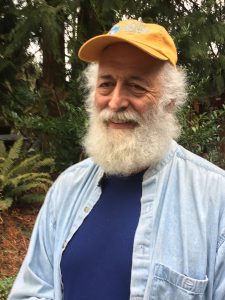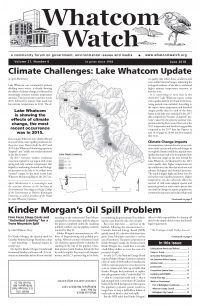by Peter Heffelfinger
One of the first chores of spring is to let a few winter-hardened brassicas, such as kales or collards, go to seed. The early flowers attract native bees and the cultivated honey bees, as well as the now commonly over-wintering Anna’s hummingbirds. Later on the seeds will feed various songbirds. The one drawback is that there will be a population of aphids on the old plants, ready to infest the next generation of brassicas. Start fresh cabbage family plants or seeds in areas of the garden that did not have brassicas last year. Rotation is the key.
This spring in my part-shady and part-sunny forested backyard I continued planting native shrubs to attract birds and insect pollinators, as well as to expand the general wildlife habitat. Ordered through the local Soil Conservation District, the bare-root starts of Indian Plum, Red Flowering Currant, and Pacific Ninebark will fill in between the existing Ocean Spray, Elderberry, Salmonberry, and Oregon Grape.
Deer Trim Shrubs
Last year the deer nibbled the tops of the Red Osier Dogwoods I put in, reaching over the tall wire cages around the new stalks. This year deer prints showed up the very next morning around the fresh plantings (Look what we found!) but no bites were taken (yet). Maybe the solution is to overwhelm the deer with a buffet of choices, so they only take a few leaves and move on. Deer traipse through the yard on a daily or nightly basis in their search for suitable browse; I can count on them trimming the Black Willow shrubs that I put in especially for them to nibble on. But I can also tell where they have tasted other things: a missing thimbleberry leaf, a cut salmonberry stalk, maybe a Lavatera branch or a Himalyan honeysuckle trimmed back.
Redirecting and dealing with wildlife is much like highway traffic control. Go here, stop there, or maybe take that newly installed roundabout ahead. Unfortunately, in a suburban, non-hunting area, deer and traffic often intersect. Crashing into a deer, especially at night, is a serious hit, usually fatal for the deer and certainly damaging to both the car and one’s nerves. For the moment the deer seem to be surviving well in spite of their losses to automobiles. And so far, unlike back East, we do not face the issue of Lyme disease from the ticks carried by deer, but the scourge will most likely arrive eventually, given the increasing migration of insect species.
Backyard Bird Sanctuary
The bird population near the house stacks up in layers. At the top of the tallest Douglas Fir the resident bald eagles perch, overseeing their nearby nest on the shoreline below. Below them, at mid-tree level, the ravens fly through daily on their commute to a neighbor who feeds them leftover meat scraps. The ravens refuse to share the free eats with the crows, who are banished to the yards at lower elevations and the beach beyond. Given the number of natural seed sources and abundant brush piles for cover, my only bird feeding regime is a suet feeder and a large bowl of water.
At the brush and ground level are the usual wrens, chickadees, juncos, and woodpeckers who are all a bit more relaxed now that our succession of Siamese cats have moved on after long lives of looking at birds but never quite catching any (that we know of). The cats were themselves potential prey for the local coyotes, who announce their territorial presence via deposits of wispy scat in highly visible spots: beside the mail-box, next to a car door, or on top of a prized fern. Our felines were always kept in at night, but several of the neighbor cats disappeared in the dark.
At my large vegetable garden near Mt. Erie, the raptors congregate on the upwelling air currents: redtail hawks, peregrine falcons, bald eagles, as well as the ospreys that fish in the nearby lakes. Relatively recent arrivals are the turkey vultures that have moved north and taken up seasonal residence. I have often had a dark shadow cruise just above me as I work in the beds, as the vultures slowly reconnoiter at almost ground level or check out any fresh road kill. It does make you feel like someone else’s dinner.
Conversely, on a recent Father’s Day I heard a distinct plop on the driveway and a shriek of annoyance: an osprey had dropped a fresh trout, either due to a loose talon grip or having been buzzed by an eagle looking to mooch a meal. In any case, the osprey flew off, too upset to retrieve its catch on land. Grateful for the gift from the sky, I made the fresh trout for dinner, a protein present for Dad. Other patrollers of the air are the welcome barn swallows, catching insects in great number with samurai-like cuts through the air. Symbols of good fortune in Japan, they are worth the fecal mess they create below their mud nests in eaves, garages or porches. An improvised cardboard shelf installed below the lip of the nest is an easy option. Homegrown guano for the garden.
The uses of floating row cover are endless. Once the pole beans begin climbing, the deer are tempted by the lush leaves. I have taken to encircling entire pole bean structures with cover to keep the herbivores away. I also encase the raspberries with it to keep off the birds that head for the ripening fruit. And the broccoli and cabbage plants stay root maggot free under their canopies held up by arches of wire.
Bunnies Sneak into Garden to Dine
The real banes of any garden are of course rabbits. I have an outer perimeter fence of chicken wire with the bottom buried in the soil, but somehow the baby rabbits always manage to get in. Then I put up portable circles of chicken wire around beds of greens or beans as a second line of defense. I keep waiting for the hawks to thin out the rabbits, but there seems a natural balance between raptor and prey. There is a family of coyotes up on the nearby ridge, which I hope will help thin out the bunnies, but the population of garden eaters remains constant. When under siege, defend your turf but plant extra to make up for the losses. A tithe for the wild.
Homes for Pollinators
The other wild, but much needed, creatures in the garden are the bees. Last summer a beekeeper set up a new hive next to the garden beds, in order to improve our pollination rates. Over the winter the hive became very strong, surviving on its own supply of honey and on the food supplied by the keeper: boiled sugar and water, made into a heavy cake of fondant, identical to the white icing on sweet rolls. Bees and humans share a sweet tooth. This spring the resident queen led a swarm out that was never recovered. The remaining larval queens, however, were propagated by the keeper into six additional hives, a great example of the symbiotic husbandry between keeper and honeybee. Bees growing bees.
Years ago, in the 1980s when the garden was new, we had hives on site that were part of a U.W. study of airborne pollution. The bees would pick up air pollution as they flew in search of pollen, as well as from the pollen itself. The scientists would gather small samples of bees, using a hand vacuum cleaner; the bees were then ground up for analysis. The lab tests detected pollution from all four nearby Puget Sound refineries, with each refinery having a distinct chemical signature. It makes one wonder if anything has changed over the years. Our current beekeeper only has hives on Fidalgo Island, keeping his broods away from the intense pesticide and herbicide applications in the Skagit Valley Flats, hoping to avoid the colony collapse disorder that threatens our nation’s food supply. He sells his honey at local farmers markets, an example of homegrown, alternative agriculture. In exchange for future honey I recently gave the beekeeper a large bundle of fresh rhubarb, an early spring fruit that certainly requires lots of sugar.
__________________________________________
Peter Heffelfinger, a Washington State University master gardener, has gardened organically on Fidalgo Island and the Skagit Flats for over 40 years. He has given workshops in year-round gardening for Transition Fidalgo/Eat Your Yard, Christianson’s Nursery, and at the Washington State University County Extension Service. He is a Salish Sea Steward, working on the invasive green crab survey.





























